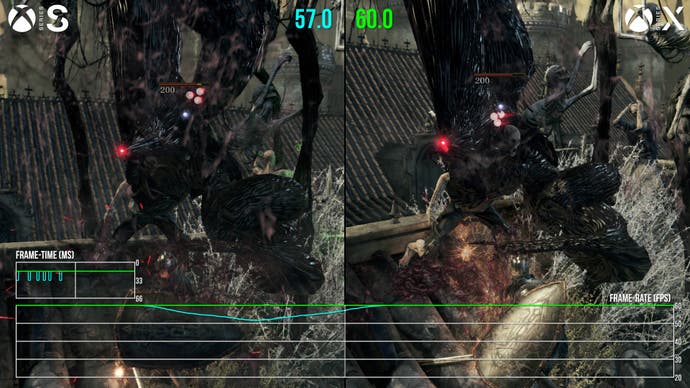Dark Souls 3 now runs at 60fps on Xbox Series X/S thanks to FPS Boost
And we've tested it.
Dark Souls 3 has just received a new lease of life on Xbox Series consoles, thanks to the transformative powers of FPS Boost. The From Software classic now targets 60 frames per second on the new wave of Microsoft consoles, replacing the somewhat wobbly 30fps of the Xbox One rendition of the game. We had early access to the FPS Boosted rendition of the game and it certainly does the job, delivering nigh-on flawless performance on Xbox Series consoles.
This is a much-requested upgrade for Xbox Series X and S owners, bringing the game closer into line with its performance profile on PS5. Dark Souls 3 released on last-gen systems in 2016 with a firm 30fps cap, but many months later, a PlayStation 4 Pro patch removed the limit, offering frame-rates up to 60fps. Unfortunately, the value of the upgrade was questionable at the time, owing to a highly variable level of performance on Sony's enhanced machine. However, in the long run, it worked out - PlayStation 5's backwards compatibility horsepower locks the game to 1080p60.
Unfortunately, From Software never went back to the Xbox One version of Dark Souls 3 to add One X support, meaning that 900p30 has been the upper limit of performance on Xbox consoles since the game's original launch. Not only that, in common with From's other 30fps console offerings, inconsistent frame-pacing added a certain degree of judder to the game, something baked into the engine that extra back-compat horsepower could not address. Today's FPS Boost upgrade overrides the frame-rate cap to give Xbox Series X and S the same, smooth experience 60fps as PS5, with no judder, hitches or stuttering.
The result? From playing the opening hours of the game, it performs near-perfectly on both Xbox Series X and S. Practically every major locale, including the fire-spewing dragon on the High Walls of Lothric, is delivered at a smooth 60fps. And yes, that applies to both consoles as by and large, Xbox Series S runs identically to Series X for the vast majority of play. The only exception I could find was a single, brief drop to 53fps during an early fight with a mutating creature on the Lothric roof. Heavy alpha effects buckle Series S only momentarily, while this spot's not an issue at all on Series X. The results are excellent all round, but Series X has a very slight edge in consistency with the fringe cases.
There is a catch though, and it's a big one. Both Xbox Series S and X continue to run at a lowly 900p resolution. On a full 4K display, an upscaled 900p image doesn't quite cut the mustard. Basic anti-aliasing is used to cover elements like grass, which flicker with movement due to its heavy sub-pixel detail and lack of temporal anti-aliasing. Just like prior FPS Boost titles, this is because the game inherits the settings from the base Xbox One, including the original 900p native resolution. It's especially disappointing that Xbox Series X still can't push past this 900p limit - we know the hardware can do much better, given that the same game runs just fine at 1080p60 on PlayStation 5.

FPS Boost isn't enough to fix all of Dark Souls 3's problems on Xbox, but it's a still a massive improvement to the game as the 60fps upgrade works handsomely. Also, there's a tangible benefit to playing on Series X and S due to the faster loading times afforded by its faster SSD media. Fast-travelling from the initial Firelink Shrine to the High Wall of Lothric gets chopped almost in half, down to 6.7 seconds on Xbox Series X, versus the 12.3 seconds on the older Xbox One X. Not bad.
We hope this isn't the end of Microsoft's upgrades to Xbox classics. Frame-rates being boosted to 60fps - and beyond - via FPSBoost ranks as a huge advantage for Microsoft's system, and one we hope to see extended to other in-need games that still run at 30fps on Xbox, such as Sonic Generations and Batman Arkham Knight to name just two. For now, Dark Souls 3 is a markedly improved experience on Series consoles, but one that is dying to be pushed further on Series X, given the power on tap.













